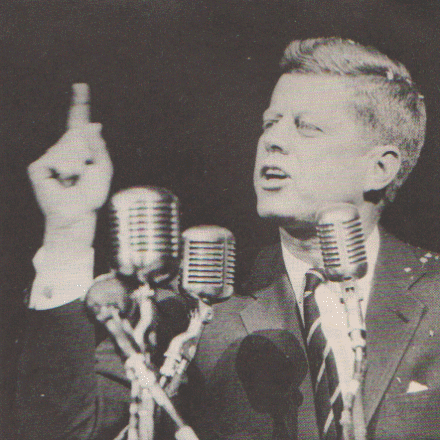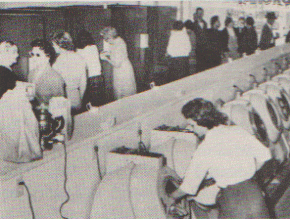Presidential Election
In the closest finish since
Benjamin Harrison defeated Grover Cleveland in
1888, on November 8, 1960, Democratic Senator
John F. Kennedy won the presidency against
Republican Vice-President Richard M. Nixon. He
brought into office with him as his
Vice-President Lyndon B. Johnson, who had been
serving as Senate Majority Leader.
The Campaign
Kennedy had to contend with anti-Catholic
sentiments throughout his campaign for the
Democratic Party nomination, as well as his
campaign for the presidency. On September 12, he
told a televised meeting of the Greater Houston
(Texas) Ministerial Association: "I believe
in an America where the separation of church and
state is absolute . . . . where no public
official either requests or accepts instructions
on public policy from . . . . (an)
ecclestiastical source." Although some
Republican leaders publicly questioned the wisdom
of having a Roman Catholic President, Nixon did
not consider Kennedy's religion to be a
legitimate campaign issue.
The campaign itself was marked by the first
ever appearance of the two candidates opposite
each other on national television in what was
billed as a series of four debates. Each
candidate made an opening statement, after which
they answered questions from newsmen. There were
a few rebuttals, and a few re-rebuttals. Although
Nixon came into the first debate with a
reputation for being a good orator, his wan
appearance and reluctance to argue with Kennedy's
viewpoint marked him as the loser. Better makeup
and a more forceful debating style made Nixon
look and sound much better in the subsequent
debates, and by the end of the fourth debate most
political commentators "scored" the
series as a draw.
A view of the studio in Washington, D.C.,
October 7, 1960, where Senator Kennedy (left) and
Vice-President Nixon are engaged in the second of
their four campaign debates. In the background is
moderator Frank McGee. In the foreground are four
newspapermen who asked the candidates questions.

Both candidates endured a strenuous schedule
throughout the campaign. Both took advantage of
jet airliners to cross the country multiple
times. Nixon visited all 50 states, while Kennedy
skipped Hawaii and five other states; Kennedy
left most of the southern campaigning to his
running mate. Kennedy employed the
"whistle-stop" technique by train in
California and Michigan, while Nixon used a train
across Pennsylvania, Ohio, Michigan, and
Illinois. Everywhere they went, each man tried to
outdo the other in crowds and voter enthusiasm.
When Kennedy was treated to a ticker tape parade
along Broadway in New York, New York, Nixon
demanded one too.
Vice-President
and Mrs. Nixon acknowledge the cheers of
a crowd lining a street in Portland,
Oregon, in September.

|
Senator
Kennedy rides in an open car to a rally
in Los Angeles, California, on November
1. The car to his right is plastered with
Nixon stickers.
 |
Vice-Presidential
candidate Henry Cabot Lodge (left) and
Nixon (right) with President Dwight D.
Eisenhower at a political rally in New
York City, New York, on November 2.
 |
Senator
Kennedy speaks at a rally just before the
November 8 elections.
 |
The Election
John F. Kennedy achieved victory by securing
three New England states and other northern
states with heavy electoral votes, along with
seven southern states. Richard Nixon made the
final tally close by sweeping most of the west,
running strongly in the midwestern farm belt, and
by securing three New England states, Kentucky,
and Oklahoma. He lost most of the industrial
states, however, and won only three southern
states.
The
grass skirt visible beneath the curtain
on the left hints at this voting booth's
location, Honolulu, Hawaii; it was the
first chance for Hawaiians to vote in a
U.S. presidential election.
 |
A
Jacksonville, Florida, woman loads a
washing machine while other citizens vote
at booths installed at the laundromat.
 |
Because of the close margin in
several states, Republican national chairman
Thruston B. Martin raised the issue of whether
there had been any election irregularities. Nixon
disassociated himself from this movement,
however, and issued a statement through aides
that he would stand on the count which showed
Kennedy the winner.
Richard Nixon, with his wife Pat at his
side, addresses party workers at Los Angeles,
California, early in the morning of November 9 as
voting returns indicated that he would be
defeated by Kennedy.

The Vote for President by State
| |
POPULAR
VOTE |
ELECTORAL
VOTE |
| State |
Republican |
Democrat |
Other |
Rep |
Dem |
| Alabama |
237,981 |
318,303 |
7,958 |
0 |
5 |
| Alaska |
30,953 |
29,809 |
0 |
3 |
0 |
| Arizona |
221,241 |
176,681 |
469 |
4 |
0 |
| Arkansas |
184,508 |
213,049 |
28,952 |
0 |
8 |
| California |
3,259,722 |
3,224,099 |
23,261 |
32 |
0 |
| Colorado |
402,242 |
330,629 |
3,375 |
6 |
0 |
| Connecticut |
565,813 |
657,055 |
15 |
0 |
8 |
| Delaware |
96,373 |
99,590 |
720 |
0 |
3 |
| Florida |
795,476 |
748,700 |
4 |
10 |
0 |
| Georgia |
274,472 |
458,638 |
239 |
0 |
12 |
| Hawaii |
92,295 |
92,410 |
0 |
0 |
3 |
| Idaho |
161,597 |
138,853 |
1 |
4 |
0 |
| Illinois |
2,368,988 |
2,377,846 |
10,560 |
0 |
27 |
| Indiana |
1,175,120 |
952,358 |
7,882 |
13 |
0 |
| Iowa |
722,381 |
550,565 |
874 |
10 |
0 |
| Kansas |
561,474 |
363,213 |
4,138 |
8 |
0 |
| Kentucky |
602,607 |
521,855 |
0 |
10 |
0 |
| Louisiana |
230,980 |
407,339 |
169,572 |
0 |
10 |
| Maine |
240,608 |
181,159 |
0 |
5 |
0 |
| Maryland |
489,538 |
565,808 |
3 |
0 |
9 |
| Massachusetts |
976,750 |
1,487,174 |
5,556 |
0 |
16 |
| Michigan |
1,620,428 |
1,687,269 |
10,400 |
0 |
20 |
| Minnesota |
757,915 |
779,933 |
4,039 |
0 |
11 |
| Mississippi* |
73,561 |
108,362 |
116,248 |
0 |
0 |
| Missouri |
962,221 |
972,201 |
0 |
0 |
13 |
| Montana |
141,841 |
134,891 |
847 |
4 |
0 |
| Nebraska |
380,553 |
232,542 |
0 |
6 |
0 |
| Nevada |
52,387 |
54,880 |
0 |
0 |
3 |
| New Hampshire |
157,989 |
137,772 |
0 |
4 |
0 |
| New Jersey |
1,363,324 |
1,385,415 |
24,372 |
0 |
16 |
| New Mexico |
153,733 |
156,027 |
1,358 |
0 |
4 |
| New York |
3,446,419 |
3,830,085 |
14,575 |
0 |
45 |
| North Carolina |
655,648 |
713,318 |
0 |
0 |
14 |
| North Dakota |
154,310 |
123,963 |
158 |
4 |
0 |
| Ohio |
2,217,611 |
1,944,248 |
0 |
25 |
0 |
| Oklahoma |
533,039 |
370,111 |
0 |
7 |
0 |
| Oregon |
408,060 |
367,402 |
0 |
6 |
0 |
| Pennsylvania |
2,439,956 |
2,556,282 |
10,303 |
0 |
32 |
| Rhode Island |
147,502 |
258,032 |
0 |
0 |
4 |
| South Carolina |
188,558 |
198,192 |
0 |
0 |
8 |
| South Dakota |
179,017 |
128,070 |
0 |
4 |
0 |
| Tennessee |
556,577 |
481,453 |
13,762 |
11 |
0 |
| Texas |
1,121,699 |
1,167,932 |
22,039 |
0 |
24 |
| Utah |
205,361 |
169,248 |
372 |
4 |
0 |
| Vermont |
98,131 |
69,186 |
7 |
3 |
0 |
| Virginia |
404,521 |
362,327 |
4,601 |
12 |
0 |
| Washington |
629,273 |
599,298 |
13,001 |
9 |
0 |
| West Virginia |
395,995 |
441,786 |
0 |
0 |
8 |
| Wisconsin |
895,175 |
830,805 |
3,102 |
12 |
0 |
| Wyoming |
77,551 |
63,331 |
10 |
3 |
0 |
| Total |
34,108,474 |
34,221,531 |
502,773 |
219 |
303 |
*All 8 of Mississippi's
electoral votes went to unpledged Democratic
electors, all of whom voted for Harry F. Byrd.

Benjamin
Harrison
Grover
Cleveland
John
F. Kennedy
Richard
M. Nixon
Lyndon
B. Johnson
Henry
Cabot Lodge
President
Dwight D. Eisenhower
Questions or comments about
this page?
|



